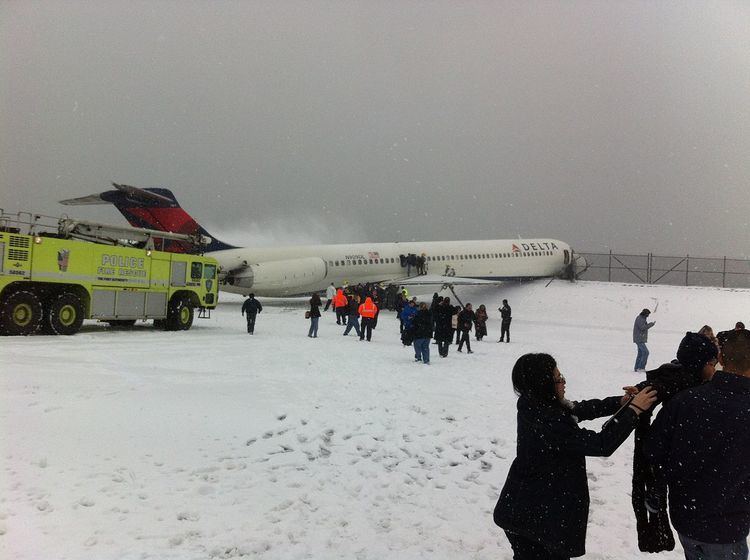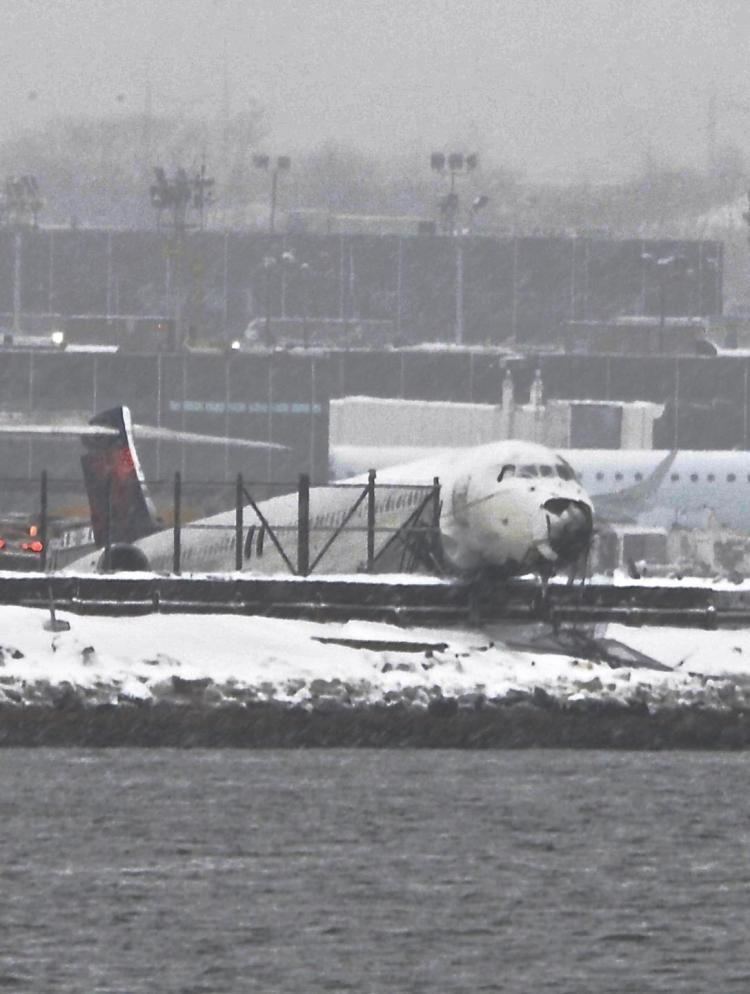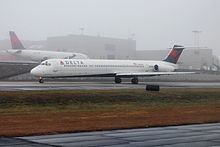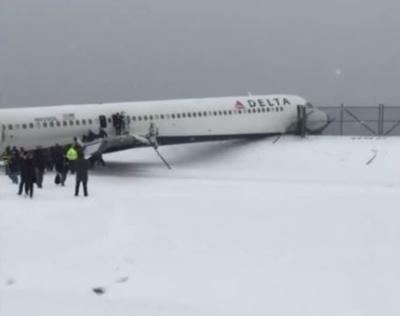Passengers 127 Survivors 132 (all) Fatalities 0 Crew count 5 | Injuries (non-fatal) 24 (minor) Date 5 March 2015 Passenger count 127 | |
Summary Runway excursion due to pilot error (excessive reverse thrust), aggravated by inclement weather Aircraft type McDonnell-Douglas MD-88 Similar 2015 Villa Castelli mid‑air co, Trigana Air Service Flight 267, Delta Air Lines Flight 1288, Air Canada Flight 624, Asiana Airlines Flight 162 | ||
Inside cabin of delta air lines flight 1086 following march 2015 crash
Delta Air Lines Flight 1086 (DL1086/DAL1086) was a scheduled Delta Air Lines domestic passenger flight between Atlanta and New York's LaGuardia Airport. On March 5, 2015, the McDonnell Douglas MD-88 aircraft veered off the runway shortly after landing at LaGuardia Airport in New York City. The plane ran up the seawall berm and struck the perimeter fence, sliding along it for approximately 940 feet (290 m) before coming to rest with the nose of the aircraft hanging over the berm above Flushing Bay. There were no fatalities, although 24 people suffered minor injuries. The aircraft was seriously damaged.
Contents
- Inside cabin of delta air lines flight 1086 following march 2015 crash
- Delta air lines flight 1086 atc recording runway excursion pilot error poor weather conditions
- Aircraft
- Background
- Accident
- Investigation
- Passenger count
- References

The final report by the NTSB found the probable cause of the accident was the pilot flying's "inability to maintain directional control of the airplane due to his application of excessive reverse thrust, which degraded the effectiveness of the rudder in controlling the airplane’s heading."

Delta air lines flight 1086 atc recording runway excursion pilot error poor weather conditions
Aircraft

The aircraft involved was a McDonnell Douglas MD-88, registration number N909DL, serial number 49540, manufactured in July 1987 and delivered new to Delta on December 30, 1987. It had accumulated 71,196 total flight hours and 54,865 total flight cycles prior to the accident. It was owned and operated by Delta ever since the aircraft was put into airline service.

Regularly-scheduled 600-flight hour, 2200-flight hour, and 760-day maintenance checks were completed in the six months prior to the accident, all with no discrepancies. The aircraft's last major maintenance check was on September 22, 2014, in Jacksonville, Florida and included, among other things, tests of the autobrake, anti-skid and auto-spoiler systems. The aircraft's last overnight service check was completed March 2, 2015 in Tampa, Florida.
Background

Flight 1086 took off from Hartsfield–Jackson Atlanta International Airport at 8:45am EST, and was scheduled to land at LaGuardia Airport at 10:48 am. LaGuardia Airport was under falling snow and freezing fog conditions at the time of arrival, with the captain reportedly telling passengers that weather problems could cause a delay. Another Delta Air Lines MD-88 had landed on runway 13 about three minutes prior to flight 1086. The pilots of this preceding flight confirmed that air traffic controllers relayed the braking action reports to the flight crew of Delta 1086; these reports were based on pilot reports from two other flights that landed several minutes prior to flight 1086. Both earlier flights had reported the braking action on the runway as "good." Statements by the pilots to the NTSB after the crash revealed that the runway appeared all white (covered with snow) when the airplane descended out of the overcast, moments before landing.
Accident

The aircraft was approaching runway 13 to land on what appeared to be a normal final approach. The aircraft was aligned with the runway centerline, and the autopilot remained engaged until the aircraft was about 230 feet (70 m) above ground level, and airspeed during the final approach was about 140 knots (160 mph), and 133 knots (153 mph) at touchdown. The aircraft touched down at 11:02 am with the main landing gear close to the runway centerline. The MD-88 veered off the left side of the runway shortly after touchdown, about 3,000 feet (910 m) from the approach end of the runway, on a heading approximately 10 degrees left of the runway heading. The MD-88 skidded left across the snowy airfield until about 4,100 feet (1,200 m) from the approach end of the runway, when the aircraft ran up the berm and the left wing struck the airport perimeter fence. It then was forced back onto a heading parallel with runway 13, and continued sliding in this direction for another 900 feet (270 m) along the perimeter fence, before coming to rest about 5,000 feet (1,500 m) from the approach end of runway 13, with the nose of the aircraft hanging over the berm. The left wing of the aircraft destroyed approximately 940 feet (290 m) of airport perimeter fence.
The aircraft sustained significant structural damage. There was major damage to the left wing's leading edge, leading edge slats, trailing edge flaps, and spoilers. The left wing fuel tank was breached near the outboard end of the outboard flaps. The front radome and weather radar were heavily damaged, and damage to the underside of the fuselage extended from the front of the aircraft all the way back to the left front passenger door. The nose landing gear well and the main electronics bay also were damaged.
The crew of the plane managed a complete evacuation only after more than 17 minutes, while the aircraft was leaking fuel. Twenty-three or twenty-four passengers received minor injuries, but all injured passengers had been sent home from the hospital by March 9, 2015.
The airport was closed immediately after the accident at approximately 11:00 am. Runways were reopened beginning at 2:30 pm. Runway 13 was closed until 10:30 am the next morning as emergency services cleared the accident site and the aircraft was removed into a hangar. Several passengers took pictures and videos of the aircraft and site after the accident; these were quickly circulating on the internet shortly after the accident.
Investigation
On March 6, 2015, the NTSB reported that the cockpit voice recorder was successfully downloaded, and contained two hours of good quality recordings and captured the entire flight. Also, the flight data recorder (a 25-hour tape-based recorder) was examined and found to have captured the entire flight and approximately 50 parameters of data, including airspeed, altitude, heading, and information on engines and flight controls, among other data. An NTSB meteorologist examined the weather conditions at the time of the accident, to determine if weather was a contributing factor to the accident. The NTSB also analyzed and developed the transcript of the cockpit voice recorder.
NTSB investigators examined and tested the antiskid, autobrake, and thrust reverser systems on the aircraft. The autobrake selector switch in the cockpit was found in the "max" position. The tailcone handle in the main cabin had been actuated, presumably for evacuation purposes, and the rear tailcone had detached.
Initial statements given by the pilots to the NTSB reveal a number of factors that may have contributed to the accident. The pilots stated they based their decision to land on braking action reports of "good," which they received from air traffic control before landing (based on reports given by aircraft landing immediately before them). Another Delta MD-88 landed on the same runway just three minutes prior to the accident flight's landing. The runway appeared "all white" to the pilots when they broke out of the overcast, indicating it was covered with snow. The NTSB investigation found that runway snow clearing had most recently taken place about 20–25 minutes prior to the accident. Upon landing, the pilots noted that the automatic spoilers did not deploy to slow the aircraft as they should have, but the first officer quickly deployed them manually. Also, the autobrakes were set to "max," but the pilots did not sense any wheel brake deceleration. The captain also reported that he was unable to prevent the airplane from drifting left.
According to the NTSB investigation update issued on April 2, 2015, investigators found that Delta's MD-88 pilot operational materials (manuals) contained guidance recommending that pilots limit the reverse thrust engine pressure ratio (EPR) to 1.3 when landing on "contaminated" runways, i.e., runways with increased levels of risk related to deceleration and directional control. However, the investigation has found that the EPR was at 1.9 at six seconds after touchdown, based on readout from the flight data recorder. The investigation also found that, upon landing, brake pressure increased in a manner consistent with autobrake application.
According to a Wall Street Journal article published March 9, 2015, "Pilots and air-safety experts have long known that when the MD-88s reversers are deployed, its rudder, or large vertical tail panel intended to help turn the nose, sometimes may not be powerful enough to control left or right deviations from the center of runways."
The final report by the NTSB found the probable cause of the accident was the pilot flying's "inability to maintain directional control of the airplane due to his application of excessive reverse thrust, which degraded the effectiveness of the rudder in controlling the airplane’s heading." Flight number DL1086 is no longer in use.
Passenger count
Among the passengers on the flight was New York Giants tight end Larry Donnell. Donnell was not injured.
